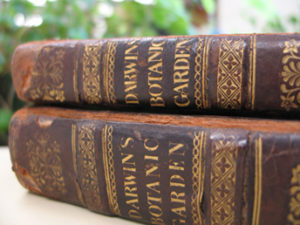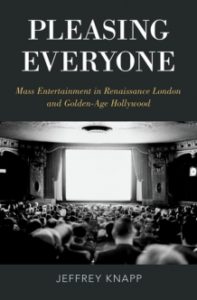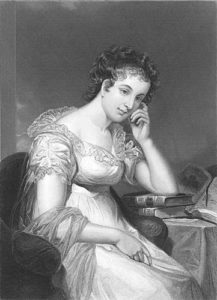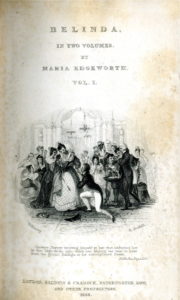by Dahlia Porter
The essay begins:
It is now commonplace to say that the canon wars of the 1980s and early 1990s provoked changes to anthologies in the following decades. What we read in the Norton, Blackwell, or Broadview anthologies of British or American literature is not what we read thirty years ago. The change has been characterized as a movement away from aesthetic criteria—Matthew Arnold’s famous “the best which has been thought and said in the world”—to a more representative selection, one that conveys the diverse literary landscape of a defined historical period or national tradition. In the 1990s, space opened for underrepresented authors, genres, historical moments, and worldviews; John Milton and William Wordsworth now mingle with Anne Finch and Olaudah Equiano, appearing alongside anonymous popular ballads, snippets of periodical essays, excerpts from novels, and a smattering of letters and speeches—varied content that projects an overall tilt toward diversity of matter, form, and authorial identity. Ours is not, however, the diversity promoted by the literary miscellany, that popular, eclectic, omnivorous genre so omnipresent in earlier periods. Twenty-first-century anthologies seek to represent a broad and varied spectrum of literary production, but they retain a defining feature of the anthology as it was consolidated at the end of the eighteenth century: organization by author in chronological sequence. Even with the addition of thematic sections, anthologized literature as we know it today remains fundamentally historical, and each selection implicitly functions as a representative specimen, an illustrative example standing in for a larger authorial corpus or class of work.
The justification for a literary collection based on historical representativeness—the legitimating force behind modern anthologies of English, American, or Anglophone literature—emerged in Britain around 1800. It was spurred, as I will argue here, by dramatic changes in what we see as a distinct sphere of knowledge making—namely the collection, organization, naming, and representation of plants in the previous century. This claim is not as surprising as it may seem. Botanical metaphors for the poetic collection have a very long history. Rooted in the Στέφανος, or garland, of Meleagar of Gadara and the Silvae of Statius, for centuries verses have been gathered up into florilegia, anthologia, sylvae, gardens, garlands, woods, wreaths, bouquets, and anthologies, this last from the Greek ἀνθολόγιον, a gathering of flowers. In Britain, collections of vernacular poetry were ushered in with titles like England’s Parnassus; or, the choicest flowers of our modern poets (1600) and Belvedere; or, The Garden of the Muses (1600). Tropes of the bouquet, garden, and forest were regularly deployed throughout the seventeenth and eighteenth centuries to legitimate the heterogeneous content of verse and prose collections, but the field of nineteenth-century literary annuals was lush with these figures. This efflorescence of the botanical metaphor for collections was spurred by a vigorous debate about the purpose, audience, and content of poetic collections in the decades around 1800. At the turn of the nineteenth century, compilers took up botanical metaphors to argue whether a collection ought to strive for a historically representative selection or for a selection of acclaimed pieces “carelessly mingled with all the ease and wildness of natural variety.” For antiquarians like Henry Headley, George Ellis, and Robert Southey, compilation was a recovery project, a method of preserving worthy specimens of poetry from oblivion; for their contemporaries Vicesimus Knox, William Mavor, and Samuel Jackson Pratt, among many others, the ideal collection contained a great variety of the most influential, recognized, elegant work, poems of unquestioned merit that displayed the richness and vitality of the poet’s genius, an image of living nature. Carried out in the prefaces, title pages, tables of contents, and introductions to collections, this contentious debate predicted the agon of the canon wars.
Scholars of late eighteenth- and early nineteenth-century poetic collections have noted the abundance of botanical metaphors, even occasionally employing them to structure their own arguments about literary compilations. Most studies of poetic collections in Britain before the twentieth century, however, focus on a set of issues common to miscellanies and anthologies: the economics of the publishing market, changes in copyright law, canon formation, expanding readerships, and editorial practice. Critics have frequently used literary anthologies to take the pulse of the eighteenth-century book trade: printed anthologies and miscellanies proliferated throughout the period, and the forms they took responded (at least in part) to ongoing legal disputes over publishers’ rights to valuable literary property, increases in literacy and access, and changing technologies of print. Scholars agree that the form and function of the anthology shifted in the decades around 1800, but they disagree about exactly when it occurred, how it was manifested, and what provoked this change. I won’t claim to fully resolve this conundrum, but I will insist that we need to look outside the narrow field of poetic or even literary collecting to understand the changing cultural role of anthologies and miscellanies—and even single-author collections of verse—in the Romantic period. Beyond Barbara Benedict’s acknowledgement that “it is no coincidence that the genre of the literary collection crystallized during the long eighteenth century when collecting itself became a popular activity” as a form of self-fashioning for the emergent middle class, existing studies take little notice of nonliterary collecting practices. As I will argue, Romantic-era collections of poetry were not just metaphorically but also materially conditioned by the projects of botanical collecting, preservation, classification, description, and illustration of the previous century. Editors legitimated their selection and organization of poems in collections by trading on the aesthetic paradigms and material practices of botanical science and art. Further, the evaluative principles structuring poetic collecting in the Romantic period emerged when editors drew on, separated, or combined competing strands of Enlightenment natural history, specifically Linnaean taxonomy and Buffonian vitalism.
A pointed antagonism between taxonomic representativeness and an aesthetics of vital nature is thus central to my argument. The dominant theory of poetic collecting in late eighteenth-century Britain replicated a desire in visual and verbal art to represent the vitality of living nature, a trend spurred by transformations in botanical description and illustration. A confluence of factors changed botanical collecting and publishing in the eighteenth century, including shifts in the geographies of collecting; developments in conventions of botanical naming and systems of nomenclature; the emergence of vitalist theories in natural history; and the application of eighteenth-century aesthetic theories to scientific illustration. As a result of these shifts, living plants were collected, dried, and pressed in a hortus siccus (an herbarium or book of dried plants), becoming botanical specimens that were subsequently imbued with the semblance of life in drawings, paintings, and engravings. This process—what I call aesthetic reanimation—reveals how scientific and aesthetic paradigms merge to dismantle and remake objects of botanical knowledge in print. I trace the consolidation of reanimation as an aesthetic paradigm as it was formulated in William Hogarth’s Analysis of Beauty (1753) and applied to botanical illustration by a group of artists employed by Joseph Banks to illustrate the specimens collected on Capt. James Cook’s Endeavour voyage of 1768–71. I then detail how the reanimated plants of eighteenth-century botanical illustration enter the lexicon of Romantic poetry with Erasmus Darwin, grandfather of Charles Darwin and progenitor of an early theory of evolution. Embracing the animating power of prosopopoeia, E. Darwin translated the aesthetic principles of botanical illustration into his two-part allegorical poem, The Botanic Garden (part 1: Economy of Vegetation, 1791; part 2: Loves of the Plants, 1789). In this heavily annotated and illustrated poem, Darwin combines taxonomy with vitalism to promote a particular brand of poetic and aesthetic vitality, one that defined the “nature” of plants collected in his poetic-botanic garden.
Romantic poets variously mobilized and resisted the conventions introduced by Darwin: the philosophical tenets of Enlightenment vitalism find outlets in individual poems ranging from William Wordsworth’s “Lines Written in Early Spring” to Percy Shelley’s Sensitive Plant to John Clare’s ballads. But more important for my argument here, Darwin’s reanimated poetic garden concomitantly changed how authors and editors thought and wrote about poetry in the aggregate. Books of pressed plants, catalogs of specimens, and anthologies of poems began to stand in for one another, their contents crisscrossing disciplinary boundaries in the process of consolidation. These conflations imbued the long-standing botanical metaphor for the poetic collection with a new urgency: as Charlotte Smith’s Conversations Introducing Poetry (1804) reveals, the content and structure of a literary collection of verse might intervene in larger debates about natural history and its representational practices. At the same time, the antipodal figures of the reanimated plant and the dead specimen provided the rhetorical ground for competing versions of literary history and evaluation in the period. The resurgence of botanical metaphors in this period signals a new division in poetic collection, a gulf between vitalist aesthetics and the collection as historical medium, a site where the present of literary culture negotiates its past and writes its future. Turning back to this formative moment in the history of literary collecting illuminates how literary history became embedded in our own anthologies of culled flowers. Continue reading …
This essay argues that the modern literary anthology—and specifically its aspiration to delimit both aesthetic merit and historical representativeness—emerged as a response to changes in eighteenth-century botanical collecting, description, and illustration. A dramatic upsurge in botanical metaphors for poetic collections around 1800 was triggered by shifts in the geographies, aims, and representational practices of botany in the previous century. Yoking Linnaean taxonomy and Buffonian vitalism to Hogarth’s line of beauty, late eighteenth-century botanical illustrations imbued plucked, pressed specimens with a new vitality. Erasmus Darwin’s Botanic Garden (1789, 1791) translated the aesthetic reanimations of visual art into a collection of poetic specimens, spurring compilations that promote a vitalist standard of literary value. By rejecting aesthetic reanimation as the figurative ground for poetic collecting, Charlotte Smith and Robert Southey forward an alternative historical model of literary merit, one grounded in the succession and continuity of representative literary types. These competing metrics for selection and valuation underwrite the anthology as we know it today.
DAHLIA PORTER has taught literature, book history, and the history of science at the University of Glasgow, University of North Texas, and Vanderbilt University. Her book Science, Form, and the Problem of Induction in British Romanticism is forthcoming with Cambridge University Press, and she is a member of the Multigraph Collective, a team of twenty-two scholars who have collaboratively written Interacting with Print: Elements of Reading in the Era of Print Saturation (University of Chicago Press, 2017).
 Boccaccio is generally the least appreciated of the “Three Crowns” of the Italian literary canon (after Petrarch and Dante), yet his focus on the realistic, even gritty details of everyday life, everyday characters, and everyday language has no real precedent, at least not one of the scope of the Decameron. Studies of the novel typically identify Boccaccio’s masterpiece as an influential precursor in the development of modern literary realism, and Erich Auerbach devotes a critical chapter to the Decameron in his monumental history of Western mimesis. Although recent scholarship has called into question Boccaccio’s supposed modernity, underlining the allegorical aspects of the Decameron and its continued debt to medieval textual practices, it is difficult to deny that, at the very least, Boccaccio expands the frame of what can be legitimately represented in literature.
Boccaccio is generally the least appreciated of the “Three Crowns” of the Italian literary canon (after Petrarch and Dante), yet his focus on the realistic, even gritty details of everyday life, everyday characters, and everyday language has no real precedent, at least not one of the scope of the Decameron. Studies of the novel typically identify Boccaccio’s masterpiece as an influential precursor in the development of modern literary realism, and Erich Auerbach devotes a critical chapter to the Decameron in his monumental history of Western mimesis. Although recent scholarship has called into question Boccaccio’s supposed modernity, underlining the allegorical aspects of the Decameron and its continued debt to medieval textual practices, it is difficult to deny that, at the very least, Boccaccio expands the frame of what can be legitimately represented in literature.
 Shakespeare’s plays were immensely popular in their own day yet history refuses to think of them as mass entertainment. In Pleasing Everyone, Professor of English Jeffrey Knapp highlights the uncanny resemblance between Renaissance drama and the incontrovertibly mass medium of Golden-Age Hollywood cinema. Through explorations of such famous plays as Hamlet, The Roaring Girl, and The Alchemist, and such celebrated films as Citizen Kane, The Jazz Singer, and City Lights, Knapp challenges some of our most basic assumptions about the relationship between art and mass audiences and encourages us to resist the prejudice that mass entertainment necessarily simplifies and cheapens.
Shakespeare’s plays were immensely popular in their own day yet history refuses to think of them as mass entertainment. In Pleasing Everyone, Professor of English Jeffrey Knapp highlights the uncanny resemblance between Renaissance drama and the incontrovertibly mass medium of Golden-Age Hollywood cinema. Through explorations of such famous plays as Hamlet, The Roaring Girl, and The Alchemist, and such celebrated films as Citizen Kane, The Jazz Singer, and City Lights, Knapp challenges some of our most basic assumptions about the relationship between art and mass audiences and encourages us to resist the prejudice that mass entertainment necessarily simplifies and cheapens.

 Maria Edgeworth (1767–1849) is famous for her bad plots. A contemporary reviewer of her 1814 novel Patronage complains that “the story is always the worst part of Miss Edgeworth’s novel.” There she consistently proves “inferior . . . to many of those that are vastly below her in everything else.” This backhanded compliment to a novelist publicly admired by Jane Austen and Sir Walter Scott may suggest some of the reasons that Edgeworth has fallen into neglect. Despite her popularity and widespread readership in her lifetime, particularly in nineteenth-century America, this Anglo-Irish writer of national tales and novels never fully entered the literary canon. If read at all, Edgeworth’s novels are studied in relation to questions of Irish identity and history, rather than as examples of the genre’s possibilities. This may indeed be attributable to a certain quality that many of her plots possess. In their broad outlines, they are unobjectionable, if not exciting. Their protagonists, whether old or young, male or female, aristocratic or working class, must learn to choose for themselves the way of life most productive of happiness. They need to overcome prejudice, indolence, misdirected sympathies, and unhealthy influences. The alleged badness of her plots, then, does not concern any unfamiliarity of outline. Nor does it derive from over-reliance on arbitrary events, chance encounters, or coincidences. Though these can certainly be found in Edgeworth’s plots, sometimes concentrated toward the end, they are arguably standard features of narrative and certainly of the novel by 1800. Rather, it seems that Edgeworth’s “carelessness” has to do with not sufficiently disguising the epistemological responsibilities placed on fictional plot by the development of experimental science. Her plots usually tell the story of how characters learn to think rationally. But this requires more than learning to distinguish between truth and lies, genuine and false stories or feelings. As one character in her novel Belinda (1801) puts it, “Our reasonings as to the conduct of life . . . must depend ultimately on facts.” For Edgeworth, then, plot becomes the means of producing legitimately objective facts within a fictive universe. In a twist in the dialectic of fictionality, plot has to produce a hierarchy of epistemological certainty within its own orderings.
Maria Edgeworth (1767–1849) is famous for her bad plots. A contemporary reviewer of her 1814 novel Patronage complains that “the story is always the worst part of Miss Edgeworth’s novel.” There she consistently proves “inferior . . . to many of those that are vastly below her in everything else.” This backhanded compliment to a novelist publicly admired by Jane Austen and Sir Walter Scott may suggest some of the reasons that Edgeworth has fallen into neglect. Despite her popularity and widespread readership in her lifetime, particularly in nineteenth-century America, this Anglo-Irish writer of national tales and novels never fully entered the literary canon. If read at all, Edgeworth’s novels are studied in relation to questions of Irish identity and history, rather than as examples of the genre’s possibilities. This may indeed be attributable to a certain quality that many of her plots possess. In their broad outlines, they are unobjectionable, if not exciting. Their protagonists, whether old or young, male or female, aristocratic or working class, must learn to choose for themselves the way of life most productive of happiness. They need to overcome prejudice, indolence, misdirected sympathies, and unhealthy influences. The alleged badness of her plots, then, does not concern any unfamiliarity of outline. Nor does it derive from over-reliance on arbitrary events, chance encounters, or coincidences. Though these can certainly be found in Edgeworth’s plots, sometimes concentrated toward the end, they are arguably standard features of narrative and certainly of the novel by 1800. Rather, it seems that Edgeworth’s “carelessness” has to do with not sufficiently disguising the epistemological responsibilities placed on fictional plot by the development of experimental science. Her plots usually tell the story of how characters learn to think rationally. But this requires more than learning to distinguish between truth and lies, genuine and false stories or feelings. As one character in her novel Belinda (1801) puts it, “Our reasonings as to the conduct of life . . . must depend ultimately on facts.” For Edgeworth, then, plot becomes the means of producing legitimately objective facts within a fictive universe. In a twist in the dialectic of fictionality, plot has to produce a hierarchy of epistemological certainty within its own orderings.